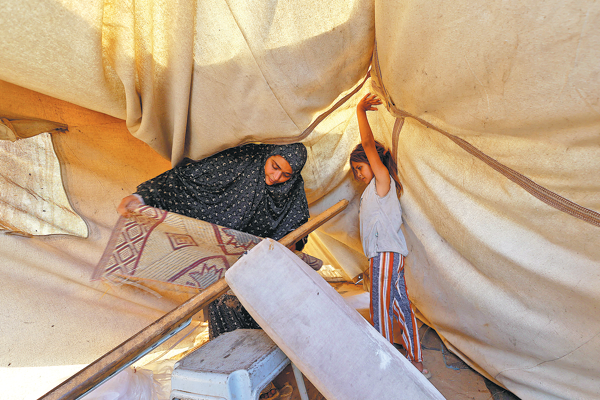A tale of passion and tradition
By ZHAO XU in New York | China Daily Global | Updated: 2019-10-02 23:43

"The very thought of eating a hamburger makes me nauseous," said Larry Hodges, a longtime table tennis player-turned-coach. "My first major title was the 1980 North Carolina Open. I was 20 then and wasn't even seeded."
"I pulled off a nice win early, and celebrated with a Quarter Pounder with Cheese," he continued, referring to the famous hamburger introduced by McDonald's in 1971. "Then I pulled off another upset, and so naturally had another Quarter Pounder."
This went on and on. Hodges ended up eating nine Quarter Pounders with Cheese, winning the under-22 singles and Open doubles, and going into the Open singles final with "a massive stomachache. I managed to win the match, barely," he said.
While Hodges has since given up the Quarter Pounders, his career has come a long way.
A recipient of the Lifetime Achievement Award from the US Association of Table Tennis (USATT) for his many years of coaching and working with the non-governmental organization, Hodges also started, together with a group of friends, the country's first successful full-time table tennis club.
Looking back, Hodges, a prolific writer and trained journalist, traced the beginning of his ping-pong love affair to a book. "Back in 1976, I was on my high school track team as a miler. One day, I went to the library to get a book on track and field and happened to look to my left," he said. There, the title on the ridge of another book caught his attention: The Money Player – The Confessions of America's Greatest Table Tennis Champion and Hustler. It is an autobiography by Martin Reisman (1930-2012), the 1958 and 1960 US men's singles champion and the 1997 US hard-bat champion.
"In a spur of the moment, I checked out that book … found a local club and went there, got killed and stuck with it," he said.
Despite later getting a bachelor's degree in mathematics, Hodges returned to the table in 1985, the year that it was announced that table tennis would become an Olympic sport for the 1988 Games in Seoul.
"I joined the newly installed resident training program for table tennis at the Olympic Training Center in Colorado Springs, and in the following years went progressively from a coach and manager to its director.
"That was when I went back to my hometown in Maryland, gained an MA in journalism and helped open the ping-pong club. All the time, I edited the USATT magazines while writing table tennis articles and books," he said. "My life has been rotating around that spinning ball."
The story of Connie Sweeris, the onetime US women's singles and doubles champion, has a more conventional start.
"Back in the 1950s, my family had a ping-pong table in our basement, like many US families did at the time," said the 72-year-old from Grand Rapids, Michigan. "My brother Bob, who played table tennis in high school, got me started: He got some books from the library on table tennis written by national players and then tried to teach me the correct strokes from the pictures demonstrated in the books.

Basement wall
"I did not always have people to practice with, so he drew a circle on the basement wall – I had to try and hit that circle as many times as I could," she continued. "Basement ping-pong, that was part of the country's collective memory. It still is."
That coaching propelled Sweeris to victory when she won the under-13 girls in the All-American Championships in 1958 in Chicago, her first tournament. By the 1970s, Sweeris was already a national champion — one without a professional coach.
"In the era I grew up, there were no programs to develop coaches or have them certified. People would play a lot of tournaments to gain experience from top-ranked players in the nation or in their own area," she said.
Her words were echoed by Dell Sweeris, 74, Connie's partner in life and competition. Playing as teenagers, the duo shared an enduring love — and four national mixed-doubles titles.
"People could not make enough money in coaching at the time," said the husband, who started coaching at 18. "I used to coach out of love, without charging a penny."
A reluctance among top US players to keep pace with the ever-evolving sport didn't help address the scarcity in coaching resources.
"We had a limited number of players and did not have the basic knowledge of the modern game – 1963 onward – to pass down to others," said Dell Sweeris, referring to a year when the 27th World Table Tennis Championships took place in Prague, and the US team finished 10th.
The Chinese, for their part, bagged gold in three categories: men's team, men's singles and women's singles. China also dominated the biennial event in 1965 and the decades to follow.
Larry, who did the page layouts and photography for Tim Boggan's History of Table Tennis, understands the mixed feelings his fellow citizens have long harbored toward the game.
"It's something in which the US had once proven a world power, through the 1930s to '50s, when the hard bat was in mode," he said. "But then the sponge bat, which gives the ball a much faster spin, was introduced in the 1950s, and by the 1960s, sponge players dominated. The US was slow to adopt, with most of its top players and juniors sticking with the hard bat at first. By the time the US players began switching to sponge, we were way behind and have never caught up."
This may explain the prevalent nostalgia among many Americans toward the hard bat. For proof, there are hard-bat events at the US Open and US Nationals, the country's top two table tennis events. Hodges himself has won five times at those events.
But things kept changing. By the time Hodges became involved in the opening of the Maryland Table Tennis Center (MDTTC) in 1992, the number of people who were sufficiently interested to pay for regular training had increased dramatically.
However, that didn't mean that business was easy, said Cheng Yinghua, a former member of China's National Table Tennis Team and a co-founder of the club.
"We struggled quite a lot at the beginning, charging a $20 per hour coaching fee. Now that amount has increased to $60 per hour at our club, while in the certain high-end ones – the Spin in New York for example – an hour's training with a pro could cost $100," said Cheng, who first met Hodges in 1988, when he was invited to coach US ping-pong players at the Olympic Center in Colorado Springs. Cheng moved permanently to the US in 1991.
"Most of my young students are from Chinese immigrant families, while most of my adult students are local Americans," said Cheng, who has 25 years of coaching experience in the US. "Why? Because the Chinese tend to be a miser towards themselves – only to save more money to spend on their next generation."
Another thing the coach has noticed is the "hidden agenda" for some Chinese students. "Of course they would love to do exercises and stay physically fit, but many of those who play really hard are also hoping that the little ball could one day lead them to a top high school or university, or at least increase their chances at doing so," he said. "This mentality has a lot to do with the Chinese parents, who almost invariably put academic pursuits on top of the agenda and who would mount tremendous pressure on their kids to achieve that goal."
However, it would be unfair to think the phenomenon is uniquely Chinese, he added.
"To evaluate a student based partly on their physical performance is nothing new to a US university looking for proof for a student's perseverance and stamina. This is the same with baseball or tennis," he said. "Ping-pong, thanks to both the early exposure through their parents and the physique of the Asian people, is a sport where students of Chinese descent could expect to stand out relatively more easily."
Yet not everyone is thinking about academic degrees. Certainly not Will Shortz, a top crossword puzzle creator, ping-pong fanatic and co-founder of the Westchester Table Tennis Club in Pleasantville, New York.
With a life running on dual tracks, Shortz churns out daily crossword puzzles for The New York Times while maintaining an unbroken run of daily table tennis playing, a stretch that started Oct 3, 2012.
"My New Year's resolution for 2012 was to play ping-pong every day. So that day in October was actually the only day in 2012 that I missed, since I had to fly to Croatia for the World Puzzle Championship," he said. "Then some film-people friends of mine suggested that I could film myself every day during play for 2013. I did it for a year, installing the camera on the other side of the table. When 2013 came to an end, I stopped filming but continued playing."

Airport to club
And he made sure that there would be no such thing as missing a day, not for illness and certainly not for air travel. "If I have to take a transcontinental flight that involves the change of dates, then I'll always go to the airport in the afternoon so that I could come in my club to play in the morning," he said. "After the plane lands, I will run to a nearby table tennis club to play. Over the past six and half years, I've done this three times."
These days, Shortz keeps a list of all the clubs he's played — 358, including 243 clubs in all 50 US states, and 17 in China, which he visited during his four trips to the country between 2011 and 2018.
"I sought out the best training facilities every time I was there for the puzzle and sudoku competitions. But I've never played with a top Chinese player, since that would be embarrassing," he said with a laugh.
One memorable moment came when Shortz stepped into the "gigantic" training room of Beijing's Shichahai Sports Team, also known as the Beijing City Team. "There were altogether 24 tables, each with a kid and his or her one-on-one coach," he said.
"Then I walked through a back door into another room with 24 more tables, followed by a third room with 12 tables, all in use. I was totally blown away by the locals' dedication to the sport," continued Shortz, who has tried with a little bit of grafting filling his 14,000-square-foot space in Pleasantville, New York, with 19 ping-pong tables shipped from China: "The ones I played on while traveling there."
Connie Sweeris, who visited China in 1971 as part of the US table tennis delegation, had a taste of the frenzy, when the Americans played friendly matches with their Chinese counterparts in Beijing in front of an audience of 18,000.
That 1971 visit, the first by any US delegation since 1949, and a reciprocal visit by the Chinese table tennis team a year later, gave rise to "ping-pong diplomacy". It also spawned, according to Dell Sweeris, a ping-pong fervor among the general American public.
"Many opportunities opened up for bigger tournaments, coaching and sponsorships. I even went into table tennis as a career between 1972 and 74," he said, offering his own thoughts on ping-pong's enduring popularity in China, as well as their dominance on the world stage.
"Both has a lot to do with state support. China has long installed a program to develop young players way earlier than the US, and to keep the very best of them on track with high-level sports schools. The state also pays for all their expenses, including living, training and traveling to international competitions," he said.
Todd Sweeris, son of Dell and Connie, had been coached by Cheng at his Maryland club before going on to compete in the 1996 and 2000 Olympics representing the US.
"At the end of the day, it's hard practice that makes all the difference," said Cheng. "How can one who trains for eight hours a week expect to compete with one who trains for 30 hours, like what I did as a young player in China? However, it must be admitted that focusing too much on one thing at the expense of others might not be a good idea, especially for a youngster."
One July afternoon in Shortz's club, people are getting down to sweating. "Here we have members from 35 countries," said Shortz, who opened the place in 2011 with his best friend and five-time champion of the Caribbean Robert Roberts.
"Twelve years ago, there were only eight full-time ping-pong clubs nationwide, compared with the over 100 we have today," Shortz said. "Judging by my experience, the soaring popularity is closely linked with the incoming of immigrants.
"They helped to rejuvenate and upgrade an old family game," he continued. "Anyone who has ever seen top-level playing would stop regarding table tennis as 'a lesser basement game', a view that has hindered its development in the US.
"Instead, it's a brainy sport in which one must constantly change strategy to exploit the opponent's weaknesses while minimizing his or her own ones," the puzzle master said.
And sometimes they hustle, as Reisman — the late ping-pong legend whose autobiography pulled Hodges into the orbit of the little ball — had done.
"To hustle means to hide your skill and win only very narrowly, so that your opponent will come back for more," said Hodges, who's now working to take his own best-selling book, Table Tennis Tactics for Thinkers, to China. The US version features Cheng on the cover.

"I met Marty many years after first encountering his book. I told him the story. His response? 'Great … another life I've ruined," said Hodges, who prizes himself on having once led one of the strongest junior teams in the US.
"At the 2000 Junior Olympic/Junior Nationals – our Maryland club had won over half of the gold medals the previous year – I promised the kids that if they won over half the golds again, I'd eat one hamburger, which I hadn't tried since 1980," he said.
"They did, and I did!"
In 2013, Shortz was in Beijing for the International Sudoku Tournament. At the news conference, the chairman of the World Puzzle Federation was seated right beside the host, a top Beijing municipal government official.
"We talked about table tennis, and he suggested hitting a few balls soon afterwards," Shortz recalled. "I was surprised by the fact that they had a ping-pong room inside municipal hall."
A moment of intense deliberation came for Shortz when the meeting was over, and he and his mayor, getting prepared for the match, went into their separate changing rooms.
"I took off my coat and slipped into a t-shirt. Then came the question: 'Should I put on shorts, or should I leave my long pants on?' It seems not right to wear shorts when you are with a very important person," said Shortz, who, after making up his mind, opened the door to find himself face-to-face with his Chinese counterpart, who had just emerged from his own room. "There he was, in table tennis shorts, ready to beat me," Shortz said.
























